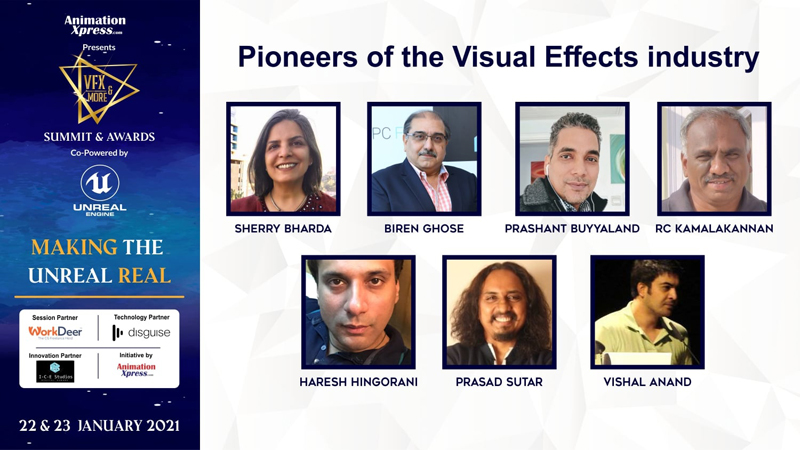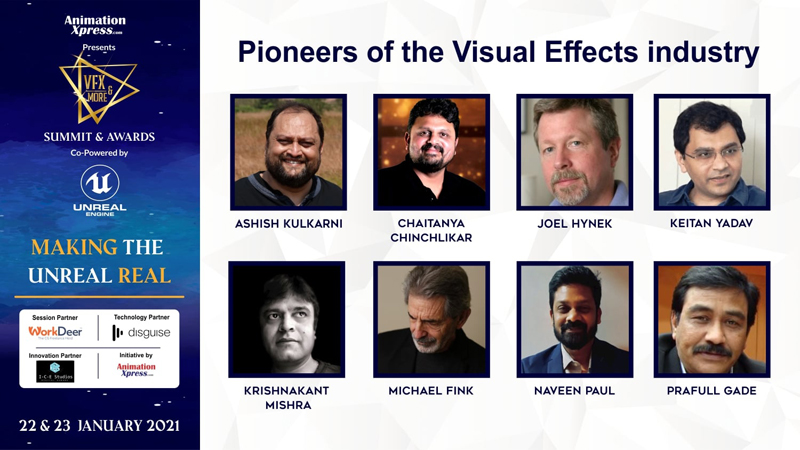
From being the post-production solution to claiming motion pictures industry’s lion share of the budget and now even making its way into pre-production, the VFX sphere has been on an upwards trajectory.
The second day of the AnimationXpress’s VAM Summit saw an insightful compendium of fireside chats, masterclasses, panel discussions and presentations by the entertainment industry’s creme de la creme, becoming a veritable vantage point for VFX sphere and by extension a go-to guide for the current generation of filmmakers.

The Evolution Of Motion Pictures
Beginning with a customary welcome note by the AnimationXpress founder chairman & editor-in-chief Anil Wanvari, the second day commenced with a keynote session on “VFX and the Evolution Of Motion Pictures” by one of Hollywood’s most distinguished VFX designers Kevin Tod Haug.
Preceded by a VFX breakdown showreel of Haug’s top-drawer projects; likes of which included blockbuster projects like Quantum of Solace, TV series American Gods, Micheal Jackson’s song “Scream” and many more, Haug’s presentation tracked the journey of motion pictures vis-a-vis effects industry right from the first motion picture by Lumière brothers who brought pictures to life with their proprietary cinématographe motion picture system to French illusionist Georges Méliès whom Kevin regards as the ‘frontrunner of visual effects‘ and the ‘world’s first VFX supervisor‘.
Throwing light on the early stages of the effects industry and its trajectory, Kevin shared, “By 1941, Linwood G. Dunn had invented optical printer and this was the beginning of visual effects moving from the motion picture set into post-production, where the movies could be better controlled and you could start telling stories in detail.” Fast forward 1982, Douglas Trumbull, American film director, special effects supervisor, and inventor made industry benchmarks by making movies 2001: A Space Odyssey, Close Encounters of the Third Kind, Star Trek: The Motion Picture, Blade Runner 2049. The thing about Blade Runner told everybody what visual effects movies ought to be about. It was entirely photo mechanical, there’s not a technique in Blade Runner 2049 that it didn’t invent and from there on it just keeps getting better and better.”
According to Haug, VFX is moving gradually away from the set; away from the creatives that work on production and into the post-production from where things can be easily controlled and the quality improves.
Speaking of what the industry has evolved to be, Kevin detailed, “We are now at the beginning of another paradigm. As we see the world around us, we realise how far have we come. From trying to portray visual images a thousand years ago to be able to create our own reality, this industry has seen a steady growth curve. The VFX we see today are things people could only imagine merely a few decades ago. The increased efficiency, creativity and sustainability of the industry has led to new talents contributing their ideas.”
The VFX service Engine: The Mainstay?
Powered by WorkDeer, the following session saw an insightful discussion on “The VFX Service Engine: The Mainstay?” by who’s who of the VFX industry and the emerging VFX studios.
Many posit that India is the VFX capital of the world. With the increasing barrage of Indian names in the end credits of big-ticket global majors and international premium originals, VFX has emerged as a significant revenue driver of India’s AVGC sector. Over two-thirds of the revenue of AVGC comes from global services and yet India is a small percentage. The opportunity is indeed very large. This panel comprised of the strategists who are leading this turf. Panelists dive deeper into the growth imperatives we need to embrace in order to make progress in the years ahead.
Moderated by AnimationXpress founder, chairman & editor-in-chief Anil Wanvari, the panel included WorkDeer VP – sales & marketing Aishwarya VNS, PhantomFX founder CEO & VFX supervisor Bejoy Arputharaj, Deluxe Entertainment head of production-VFX/ Animation/Stereo Franklin Mascarenhas, Rotomaker founder & CEO Madhav ‘Mike’ Yatham, Trace VFX head of studio, Technicolor Film & Episodic VFX Mumbai Unit R.K Chand, Bot VFX co-founder & director Sreyans Bardia, Labyrinth Cinematic Solutions CEO & co-founder Sidhartha Jaykar and Digicore Studios CEO Yogesh Anand.
The panelists spoke about the Indian model of revenue and how we can restructure the fundamental strategies to allow more creativity into the industry. Panelists observed that pandemic did encourage them to rely on freelancers and industry is looking at the way in which freelancers can play a bigger role. While some panelists cited ‘data security’ and India’s traditional revenue model which is different from the west, others felt it is the lack of government subsidies and support coupled with the shortage of budgets to the VFX department as the variables responsible for the slow growth. The panel observed that even studio heads need to come forward and take the necessary steps to evolve India’s VFX industry and take it to the next level.
Raised By The Wolves
The next session saw a marvellous VFX breakdown of Sir Ridley Scott’s groundbreaking series Raised By the Wolves. Senior VFX supervisor Ray McIntyre Junior began by explaining how he created the VFX shots for the series and answered various questions about the techniques being deployed for the season two. He also touched upon the trends that the VFX industry is witnessing in the recent times.
After delving deep into the use of technologies like Lidar scanning and Photogrammetry in order to take real-life references for creating CG environments, Ray alluded to the wonders of virtual production that filmmakers are increasingly cottoning up to.
Analysis of the VFX industry
The summit’s cart turned in the direction of statistics with a definitive presentation by KPMG India Head & Partner – M&E Girish Menon. While Menon pointed at the dip that the industry experienced during the outbreak and lockdown, he also spoke about the growth owing to the opening up of content pipelines and the rising interest in virtual production technologies.
The session was followed by India’s influential industry veterans and AVGC pundits speaking about the next triggers of growth and opportunity in the VFX sector. Moderated by Wanvari, the session saw a chat featuring Technicolor Country Head Biren Ghose and FICCI AVGC Forum chairman & Punnaryug Artvision founder Ashish Kulkarni.
While Ghose pointed out that the Indian government needs to support both big and small players when it comes to the industry as they both play a crucial role, Kulkarni spoke about how VFX supervisors are now talking to more and more directors, producers and actors and “that will sensitise them to the process of how effects industry works and the planning that needs to go behind it.” Kulkarni also highlighted that artists who have worked on global majors have increased confidence and skill. Indian artists are increasingly working on international projects.
The Democratisation Of Virtual Production – How disguise can help you use LED on set
After a short breather, the event resumed with a presentation on “The Democratisation Of Virtual Production – How disguise can help you use LED on set” by disguise EMEA Technical Solutions manager Lanz Short and chief commercial officer Tom Rockhill.
With infographics and demonstration video clips, Rockhill dived into the growing trend of virtual production and the way disguise can facilitate filmmakers with LED volumes and other ancillary solutions to ease workflows and scale up content production. Short showcased with the help of diagrams just how production can be improved using LED volumes as a backdrop instead of real locations.
The Future Of Filmmaking
The next panel participated by the world’s most reputed VFX professionals cast a deeper look into the current trends and the way content will be produced with the help of in-camera visual effects and virtual production.
Moderated by Digital Domain 3.0 VFX producer Praveen Kilaru, panelists included I-C-E Studios founder Anant Haldia, Anibrain founder & CEO Jesh Krishna Murthy, VFX designer Kevin Tod Haug, VFX supervisor & producer Ray McIntyre Jr, DNEG head of production Sesha Prasad, and disguise chief commercial officer Tom Rockhill.
While Haug spoke about the traces of virtual production in the early days when rear projections acted as the location and the real-time elements that play a key role today, McIntyre Jr highlighted the evolution of this technique and how it can be made feasible and democratised if productions could ‘rent’ time on the LED volumes instead.
Rockhill spoke about the solutions they plan to provide in all corners of the world through their expertise in this technology. Haldia revealed his plans to scan locations and provide it to make the data more democratised.
Krishnamurthy and Sesha spoke about their observations with respect to the rise of virtual production while Ray spoke of the initial planning stage of integrating virtual production that is going on for the season two of Raised By The Wolves.
Ray observed that “what really has changed from the rear projection years ago is the ability to maintain the illusion despite moving of the camera because it can be tracked in real-time with the help of game engines that move the virtual camera in tandem with the virtual environment that is on the wall.”
The Rise Of Digital Humans
The presentation on “Digital Humans” by I-C-E studio founder Anant Haldia garnered a lot of traction with attendees abuzz with questions. Viewers asked about how far away we are from creating photorealistic digital humans that look exactly like the real ones. Haldia spoke optimistically about achieving that goal if enough time and budget was provided to the team.
Haldia informed that their studio has worked with a range of movie stars, likes of which includes Shah Rukh Khan whom he has scanned multiple times for various projects including Fan and Zero.
Streamers: The New VFX Mecca
VAM Summit saw a panel discussion on “Streamers: The New VFX Mecca” which was on how the profusion of online platforms and increasing budgets opened the frontiers of high-end VFX technologies. Although pandemic has affected almost all the major industries, it has scarcely impacted virtual industries – animation and VFX, which not only survived but were up and running even during the worldwide lockdown, providing services to projects, enabling seamless entertainment to audiences.
Panelists were Vishal Furia (Criminal Justice director), Patrick Graham (Ghoul and Betaal writer-director), Devendra Gandhi (JL50 executive producer), Arati Kadav (Cargo director), Excel Entertainment VFX Head Rajeev Kumar, and Netflix director of Visual Effects-APAC Samir Hoon. The session was moderated by Animation Xpress founder, chairman, editor-in-chief Anil Wanvari.
While VFX professionals spoke about creating VFX for their content on a budget with the help of planning things ahead of time, directors and streaming representative spoke about the allocation of budgets to the VFX in the current times.
Pioneers of India’s VFX industry
The final segment of the day saw the legends and distinguished pioneers of India’s VFX sphere discussing various aspects of their journeys. In attendance were VFX director Govardhan Vigraham, Redchillies.vfx chief operating officer & VFX producer Keitan Yadav, senior VFX supervisor & filmmaker Madhu Sudhanan, Makuta VFX division head & chief technical director Pete Draper, VFX supervisor Srinivas Mohan and Firefly Creative Studio co-founder & director Sanath PC.
Moderated by Anil Wanvari, the final session became the highlight of the day with the unprecedented spectacle of India’s VFX gems and national award winners fondly recounting the early days and the way industry has progressed. The session was followed by citations and honouring of the VFX leaders and professionals who laid down the pillars of India’s VFX ecosystem in the early days and contributed significantly to take it to the next level.
Here’s the list of the awardees who were recognised for their contribution towards India’s VFX industry and their role in taking it to great heights it has scaled today :-



The day ended on a high note with Wanvari expressing gratitude for all the forces involved in making the VAM summit a roaring success and promising to be back bigger and better!
